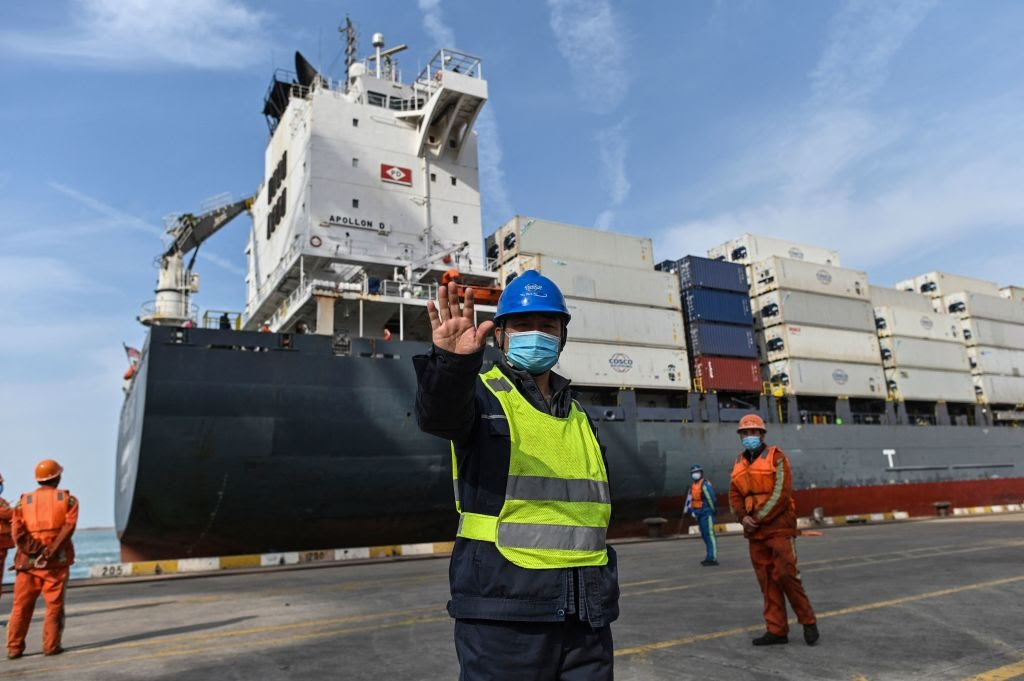| Christmas in America has been called off this year. Supply-chain disruptions in Asia mean no toys for the tots in December. As a result of a multitude of factors, freight rates have skyrocketed. The cost of hauling containers across the Pacific Ocean, for example, has increased more than 500% during the last year. Pictured: The Lianyungang Port Container Terminal in Jiangsu province, China, on March 24, 2021. (Photo by Hector Retamal/AFP via Getty Images) |
Quick, someone call Santa. Christmas in America has been called off this year. Supply-chain disruptions in Asia mean no toys for the tots in December.
At least that’s what Vice President Kamala Harris suggested on her trip to Southeast Asia, and she is right. Shelves across America were bare earlier this year, and they will, in all probability, be bare again due to extraordinary supply-chain disruptions in China and throughout East Asia.
There is one solution that eliminates these disruptions and saves the planet. Harris did not mention it, and global elites just hate it.
«The stories that we are now hearing about the caution that if you want to have Christmas toys for your children, it might now be the time to start buying them, because the delay may be many, many months,» said Harris to a roundtable of business leaders in Singapore on August 23. «So across the board, people are experiencing the issue.»
Why will American children be disappointed during the holidays? «Of course, the climate crisis is fueling a lot of this,» she proclaimed. «When we look at the stronger typhoons that have disrupted shipping lanes and sea level rise, which threatens port infrastructure as an example. So these are the many issues that are causing these disruptions.»
No, Madam Vice President, climate change has almost nothing to do with the ongoing disruptions. There are many factors, such as the long-term shift of manufacturing to East Asia. Moreover, there are short-term problems, the transport of empty containers being one of them.
Another culprit is the Delta Variant. A new wave of COVID-19 in Southeast Asia has led to lockdowns in Thailand, Malaysia, and Vietnam. In Ho Chi Minh City, authorities ordered residents starting August 23 to «stay where they are.»
Across China, lockdowns have shut factories, stopped trucking, and paralyzed ports. In May, disease closed Shenzhen’s Yantian Port, the third biggest port in Asia. Officials on August 11 closed the Meishan terminal of the Ningbo-Zhoushan Port. Meishan handles about a fifth of the traffic there, the world’s third-busiest container port.
The closure of Meishan is especially consequential for American consumers because shippers use Ningbo to load cargo for Long Beach. Moreover, the closure could not have come at a worse moment. August is the peak shipping time for the day after Thanksgiving, better known in American retailing circles — and around kitchen tables across the U.S. — as Black Friday.
As a result of a multitude of factors, freight rates have skyrocketed. The cost of hauling containers across the Pacific Ocean, for example, has increased more than 500% during the last year. Spot rates — rates reflecting current pricing — on China-U.S. East Coast routes were $20,804 the first week of August; they were under $11,000 on July 27.
«These factors have turned global container shipping into a highly disrupted, under-supplied seller’s market, in which shipping companies can charge four to ten times the normal price to move cargoes,» said Philip Damas of maritime consulting firm Drewry, referring to typhoons and COVID rules. «We have not seen this in shipping for more than 30 years.»
High shipping costs do not appear to be a temporary phenomenon. Damas expects «extreme rates» to continue until next year’s Lunar New Year holiday, but some predict they will continue until at least the end of 2022, especially as ships are pulled off routes to convert them from dirty bunker fuel to cleaner natural gas and diesel.
August 20 saw an all time-record for ships backed up off the container ports of Los Angeles and Long Beach. Yet container disruptions are not end of the story. «There’s another massive shipping traffic jam out there, one that’s holding up even more cargo,» reports FreightWaves. The disruptions in the bulk cargo sector are even worse, in part due to China’s strict COVID rules, especially quarantines imposed on pilots.
Nick Ristic, dry-cargo analyst at Braemar ACM Shipbroking, reports that in mid-August there were 1,692 bulkers with an aggregate capacity of 142 million deadweight tons waiting in queues around the world. That was, he says, «the highest level we have on record and about 15% higher year-on-year.»
Expect retail prices in America to go up. If you’re the shipping manager for Apple, you don’t really care because the additional costs for shipping, say, an iPhone are negligible.
The added costs are not negligible, however, if you make larger items. «A 40-foot container can hold 20 sofas,» Jonathan Bass, CEO of home décor firm WhomHome, tells Gatestone. «The dramatic increase in rates — it can now cost $25,000 to ship a container across the Pacific to the East Coast—adds about $1,625 per sofa.» That increased cost puts this furniture item out-of-reach for most consumers.
What to do? During Harris’s trip, the White House announced that the U.S. Department of Commerce and the Singapore Ministry of Trade and Industry had formed a partnership «to enhance supply chain resilience.» She raised the issue continually during her Singapore visit, even discussing the matter with Prime Minister Lee Hsien Loong.
«There’s so much in particular about the pandemic that highlighted the fractures, and the failures, and the fissures in our system,» Harris said in her meeting with Lee. «And this moment gives us the opportunity then born out of crisis to actually fix and find solutions to long-term issues that have challenged us.»
Bass, a near-shoring advocate, has a fix: «Now, given shipping costs and other factors that are not temporary, it would be cheaper to makes sofas and other items in North America.»
Vice President Harris, who believes just about all the world’s problems result from climate change, should be happy with that solution, because it would eliminate carbon emissions from trans-Pacific shipping. «The world’s cargo fleet heats waters at the rate of four nuclear bombs per day,» Bass notes.
Moving production would not only employ North Americans and bring prosperity back home, it would also mean that Americans would stop funding a hostile Chinese regime that, among other things, just labeled the U.S. an «enemy.»
Let us remember: Every single sofa that Americans buy from China gives its malicious regime the funds to grow biological weapons, dig missile silos, and develop even more means to kill Americans. So every sofa we build on this side of the Pacific helps defend the American republic.
Gordon G. Chang is the author of The Coming Collapse of China, a Gatestone Institute distinguished senior fellow, and a member of its Advisory Board.






